I spent decades travelling to all corners of New Zealand thanks to my work in television. Because of all this domestic travel, I feel qualified in speaking about the amazing spaces of this little country and have covered many of the scenic wonders in previous blogs. With future international travel looking more difficult for a few years, the focus is for kiwis to explore their own country. These upcoming local travel blogs should also be of interest to my overseas readers who have an interest in New Zealand. I have chosen each location for the unique atmosphere found there as well as the scenery, and in some cases, the fascinating history. Let’s get started with two of them, one in the South Island the other in the North Island..
ST BATHANS
St. Bathans is practically lost to history and is almost a ghost town. Technically, it is really just a settlement but it is truly an enchanting place and is becoming increasingly popular with tourists. At its peak in the 1860s, there were well over 2000 residents but today, less than 10 people live in this tranquil gem of a settlement.
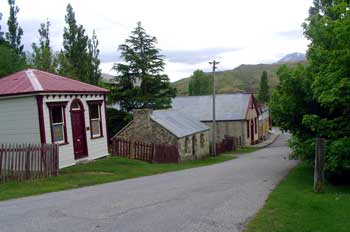
St. Bathans is not easy to find. Its isolated location on the edge of the Maniototo Plain, in a gully below the Dunstan Mountain Range, only adds to the special atmosphere you experience here. A narrow, winding feeder road joins it to the ‘Pig Root’, one of two roads that connect the inland towns of Central Otago to the east coast. It is a two hour drive from Dunedin. ‘Maniototo’ means ‘bowl of blood’ in Maori. Blood! Ghosts! Isolation! St. Bathans really is a different kind of place.
HAUNTED HOTEL
There used to be 19 hotels lining the main street. The Vulcan Hotel is the only one to survive and is one of the most loved buildings in the South Island. This quaint little hotel is regarded as ‘New Zealand’s most haunted pub’ and is famous for the presence of the ghost of ‘Rose’. She was thought to be a prostitute who was murdered in bedroom number one by a jealous customer who was not happy with her ‘entertaining’ other miners in town. To this day, her ghost causes guests to have sleepless nights in that room. I have stayed in the Vulcan on a number of occasions but never in room one. On one stay, a member of our crew who didn’t believe in the supernatural, opted for the small haunted bedroom. In the morning, he blurted, wide eyed, to us that he felt a chill pass through the room in the dead of night and on waking, he noticed the framed picture on the wall was upside down. It has been noted that ‘Rose’ only haunts men. Over the years, guests have reported hearing groaning in the hallway. Kettles have boiled without being turned on, and doors lock themselves. On one of my visits, the barman reported a full bottle of whisky crashing off a top shelf. A transparent form surrounded by a white mist has also been seen reclining on a chaise longue in the dining room.
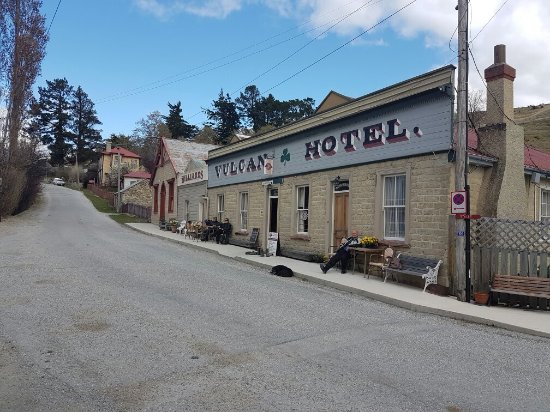
Originally called the Ballarat Hotel, the Vulcan was built of mud brick in 1882 and when I last stayed there, it had only four guest rooms. During the 1960s and 70s, the historic hotel was a popular lunch stop for commercial travelers working in Central Otago. Sadly, the interior has been ‘modernized’ to cope for the increase in trade. I remember it in its original condition with a small, wooden bar with slightly grubby spirit bottles randomly displayed on shelves and the whole bar room smelling of the dusty hessian that covered the walls.
With the development of the nearby Otago Central Rail Trail in the 1990s, the Vulcan has become more popular than ever. The shamrock that can be seen on the front of the hotel was painted there by the Irish miners who lived in the town as a statement of pride to the Welsh miners who lived in the nearby mining settlement of Cambrian, which no longer exists. The rivalry between the two settlements became known as the ‘War of the Roses’ and many a fight broke out in the numerous bars that buzzed in both towns during the area’s gold rush.
Next to the Vulcan Hotel, the St. Bathans Hall is another gem of a building. It has been restored and is a magnet for photographers who make their way to the town. The hall was built ten years after the Vulcan by the publican of the time as a venue for theatrical entertainment and is the oldest mud brick hall in New Zealand. The building has a sprung floor and the boisterous dances held there have become legendary. The Vulcan had to close its doors so men would be forced back to the hall to continue dancing with their female partners. A sizeable mural was painted on the hall’s back wall by a visiting German artist in 1876. Part of this mural is still visible today and gives a fascinating indication of the sensibilities of the period.
A few paces up the street from the Vulcan Hotel, the equally fascinating old Post office has been refurbished. The two storied wooden structure is the first major building you come across as you approach the town from the east. Built of native kauri wood, it opened in 1909 and closed in 1937. Today, the lovely old building has been partially converted into accommodation.
The little Catholic Church is one of the few churches in New Zealand to have its own graveyard. It was opened in 1892 after the first building was blown down in a storm. The Anglicans also have a church in town. The current St Albans building was shipped out from England in sections after the first church was also destroyed in a storm. The simplicity of the building’s design is part of its appeal.
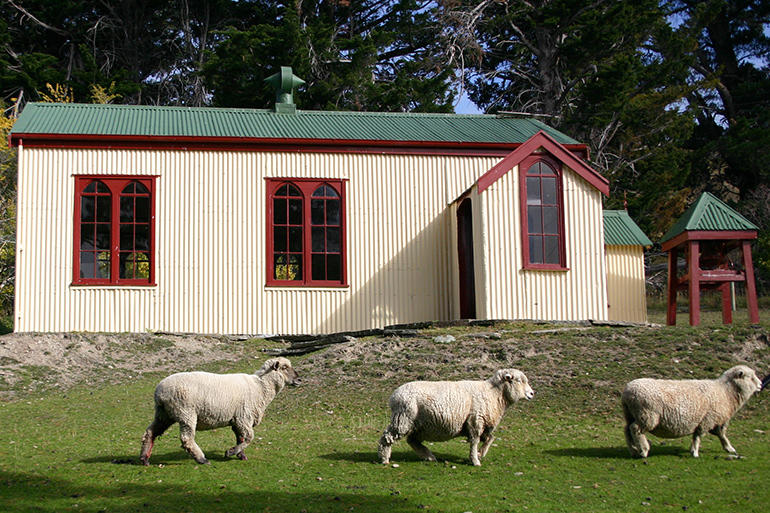
There are a number of picturesque ruins on both sides of the main street including the courthouse and the old school. A few of the original cottages have been restored. The quaint little wooden gold office was taken away in the 1970s but ten years later, it was returned to St. Bathans and placed beside the restored stone built blacksmith’s forge. I’m pleased that the billiard room built of mud brick in 1881, has also been fully restored. It is one of the few remaining buildings on the lake side of the main street and has a very pleasant appearance.
On my last visit to St. Bathans I stepped across the road from the Vulcan Hotel to the Blue Lake and immediately became aware of the stillness. There was a silence that seemed to capture my soul. There was also a calmness that has to be experienced to be appreciated. Along with the Vulcan Hotel, the Blue Lake is the other best known feature in the town. It was formed by sluicing the surrounding cliffs in the search for gold. Powerful water jets were used to form the deepest mining pit in the southern hemisphere. Over the years, this deep pit filled with vivid blue water. The little lake lacks the grandeur of other South Island lakes, but it does have its own unique atmosphere that strangely holds the onlooker captivated. I’ve never seen anyone swimming in the mineral rich blue water or boating on it. It is as though nobody wants to disturb the stillness found here. Perhaps they don’t want to upset the ghosts that provide the extra fascination people have with St. Bathans.
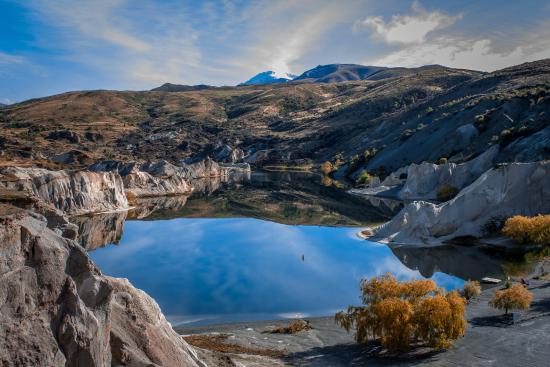
MATAKANA
Matakana’s 290 permanent residents declared their village New Zealand’s first ‘slow town’. The slow town concept was created in Italy with the idea of promoting a better way of life. Its aim was to avoid fast living in a homogenized world and at the same time, improving the environment and avoiding the development of large franchise stores. Traditions and traditional ways of doing things are valued.
When I paid my first visit to this interesting little town, I was expecting something bigger from all the talk I had heard about the place. On first appearance, there was just a quiet main street with a quaint hotel and not much else. However, a driveway off the street led to a wonderful complex of attractive shops and the best restaurant I had eaten in for a long time. I had discovered the heart of this northern settlement. It was impressive!
Matakana is an hour’s drive north of Auckland and is a rapidly growing area as wealthy Aucklanders look for peace and quiet away from the congestion of the city. There are numerous million-dollar mansions dotted around Matakana and the wealth invested in the area shows. This is a trendy little town with a sophistication not seen to the same degree in any other rural area in New Zealand. I am also convinced it has a booming future. Population flow is reversed here. Instead of people leaving rural areas for the opportunities and entertainment available in the cities, folk are moving from the city to the Matakana area.
A good example of the townsfolk’s attitude is their eye-catching public toilets. They didn’t want just the bulk standard shed. They wanted to make a statement about their town. A design competition for their public toilets was held in 2002 and 25 entries were received. The winner was a local boy in his first year studying fine arts at Auckland University. He was inspired by what he saw around his home town for his winning design. The arched toilet blocks resemble boat hulls reflecting the importance boat building has been to the area. The striking toilets, costing $400.000, are constructed of recycled kauri and concrete with copper edging. The half faces at the entrance to the toilets themselves are inspirational and I feel make the correct statement about Matakana.
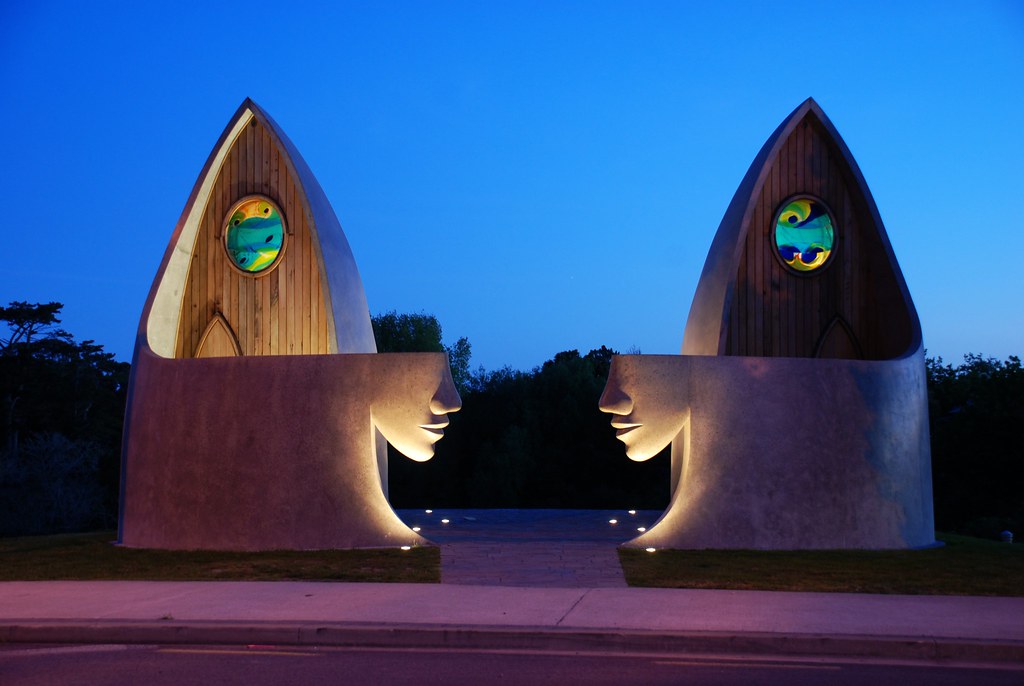
The other man-made landmark of interest in the town is the statue of King George the Fifth. It is the only statue of the king to be sculptured in New Zealand. The statue was unveiled in 1919 to remember local men who lost their lives in the First World War. In 1938, vandals lopped the head off the statue. It has been decapitated a number of times since then. The statue itself deteriorated over the years but in 2006, after the town’s inhabitants raised enough money, the damaged statue was relocated and brought back to its original condition.
As I mentioned above, the old pub was the only building to attract my attention on first arriving in the town. The Matakana, as it is called, was built by the local post master in 1903 from the timber of a single kauri tree. After he died, the pub became a boarding house for dairy factory workers. In the 1980s, it was a popular restaurant run by a Frenchman with a Michelin star tattooed on his bottom. In 1912, three farming couples and three city couples upgraded the restaurant into a cool, stylish family friendly place to relax with food and drink. Just a few paces away on the same street, a young local fashion designer has set up her shop in a tastefully painted shipping container. That’s Matakana for you!
POPULAR FARMER’S MARKET
Matakana is best known for the Farmer’s Market and has put this progressive little town firmly on the map. In fact, if it wasn’t for this popular, much talked about market, I would not have even been aware of the town. Each Saturday, hundreds of people descend on Matakana from around the region. Many make the hour’s drive from Auckland to wander around the numerous stalls selling organic fruit and vegetables, locally made chocolate, home crafted preserves, designer breads, meats, oils, wines and much more. Local musicians play live music to add to the relaxed atmosphere found here. The slow town approach to living is evident in the way the stall holders take time to discuss their produce with their customers. There is no hype or heavy selling going on, just casual conversation and the sharing of knowledge and information that is beneficial to the customer.
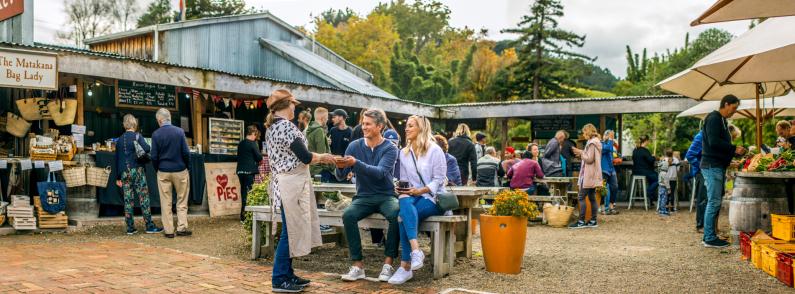
The Farmer’s Market is located within Matakana Village. This pleasant complex of specialty shops was created from the Matakana timber mill that had been on the shores of the Matakana River since the 1850s. The attractive shops sell a range of goods from books to jewelry, flowers, fashion and locally made beauty products. There is a strong emphasis on Matakana sourced products with the town’s name appearing on a surprisingly large variety of labels. Wandering around these shops on a quiet weekday is like a meditation. It is so peaceful with the only sound coming from happy sparrows chirping with excitement as they compete for the crumbs that fall from the tables of a cafe overlooking the gently flowing river.
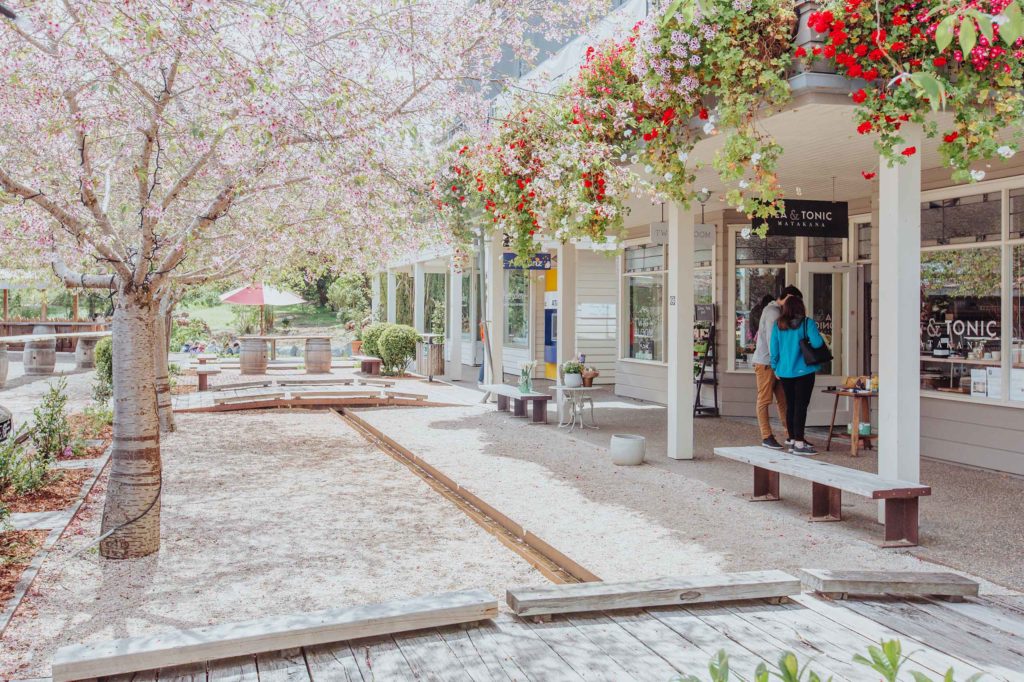
The Village complex also houses the Matakana Cinemas. Established in 2007, the three screen complex has been voted New Zealand’s top independent cinema. The small, plush auditoriums offer the relaxed environment Matakana has worked on creating since becoming a slow town.
There is a change of pace during the annual Matakana Seagull Raft Race down the Matakana River. Anyone can enter on anything that floats as long as it is powered by a 4.5hp Seagull motor. Teams have to dodge water bombs and eggs from other competitors and from an enthusiastic crowd lining the riverside. It’s a bit of fun and the money from the entrance fee goes to local charities.
The countryside around Matakana contains gently rolling hills home to a number of vineyards – and some of the best beaches in the world are nearby. The climate is temperate and the region is protected from the colder winds that impact other parts of the country. There are 30 boutique vineyards in the area and wine tasting is a popular past time for both locals and visitors. There is a sophisticated, but gentle quality of life in and around Matakana that I have not found in any other part of rural New Zealand.
St. Bathans and Matakana are two special little towns that offer a peace that soothes the soul. The gentle atmosphere and pleasant scenery only add to the appeal these places have for me.
Ceidrik Heward
Ceidrik Heward is an Amazon TOP SELLING AUTHOR and has lived and worked in 7 countries working as a TV cameraman, director and film tutor. For the past 17 years he has focused on writing and has been published in magazines and newspapers in Europe, USA, Asia and the Middle East.
His interests include photography, psychology and metaphysics. He loves to read and always has at least 3 books on the go. He has written 22 manuals/books and has just completed his 4th short novel. Ceidrik believes sharing information and stories is the best way to stimulate the imagination and enrich our lives.
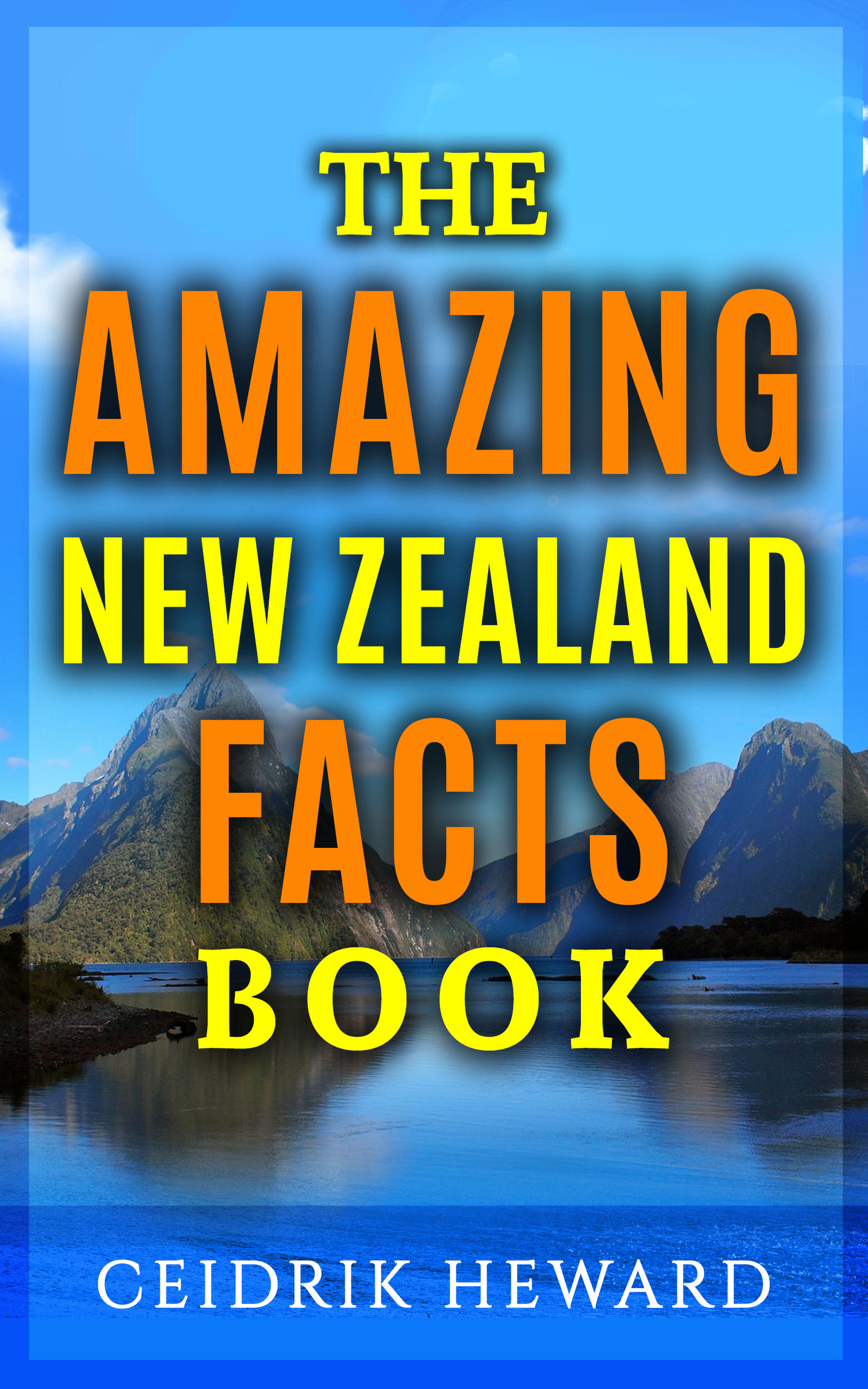
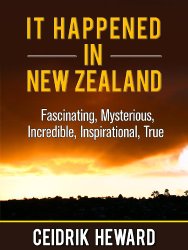
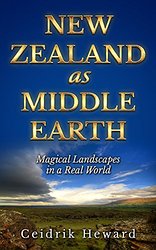
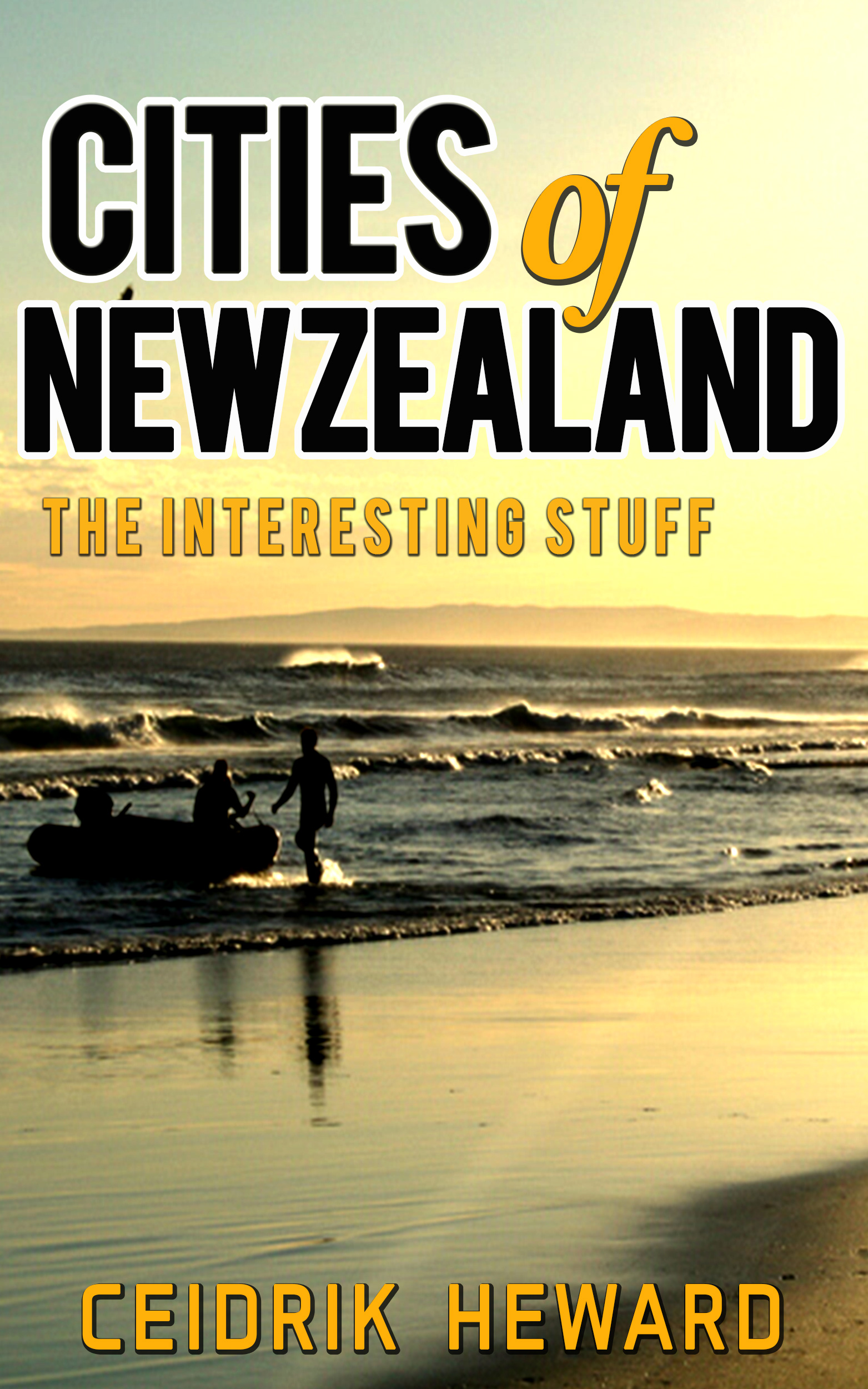
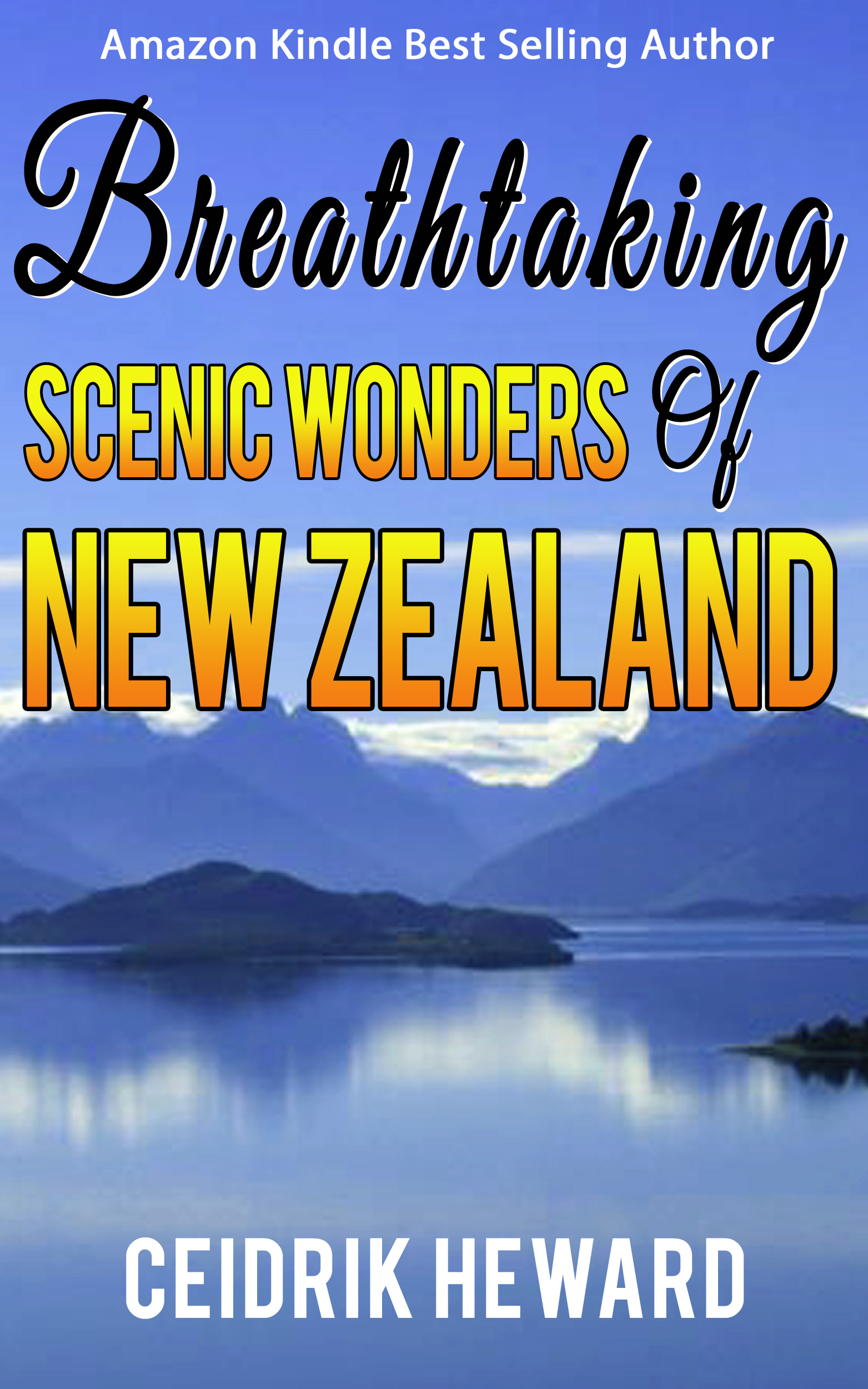
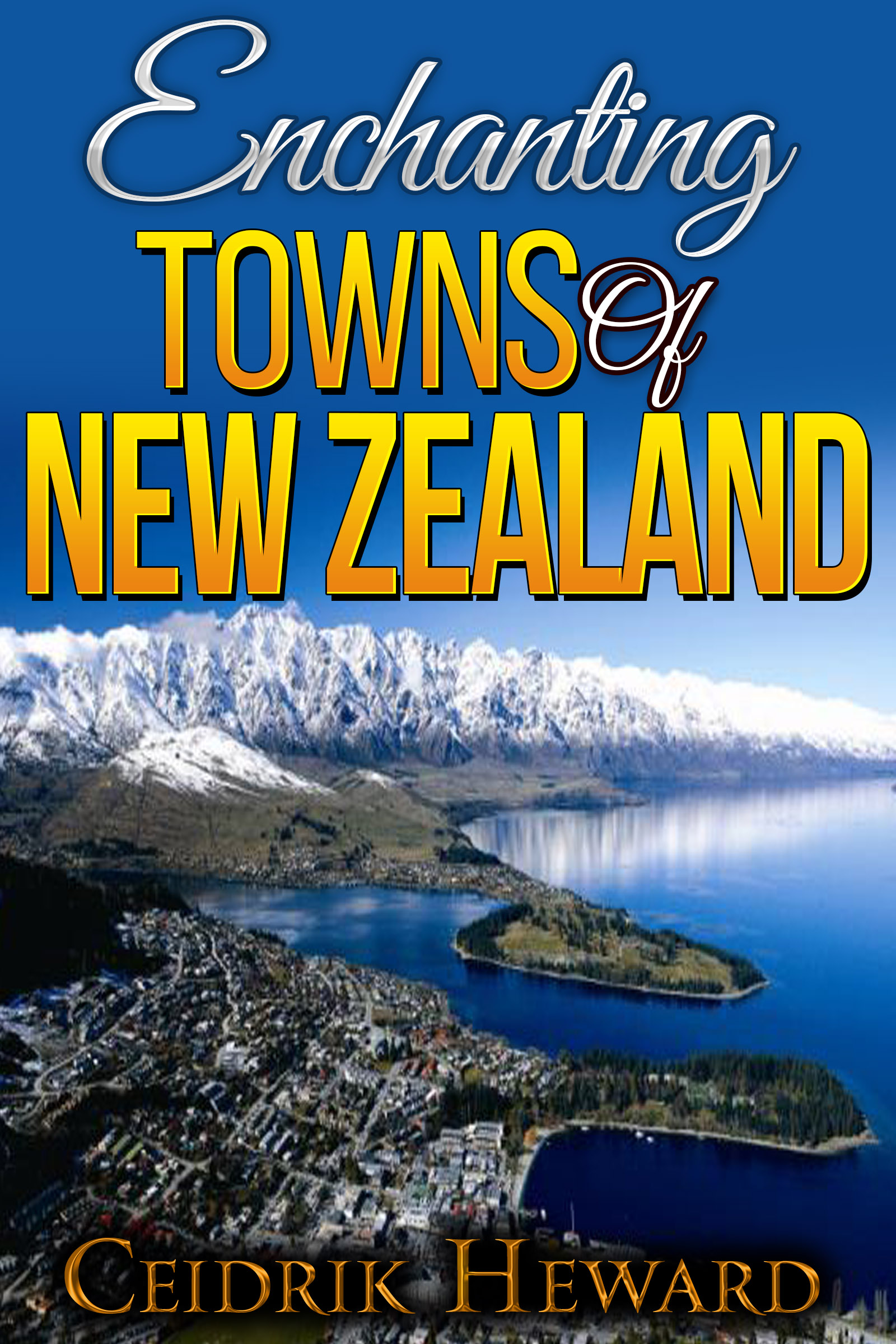
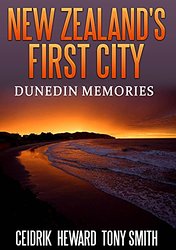

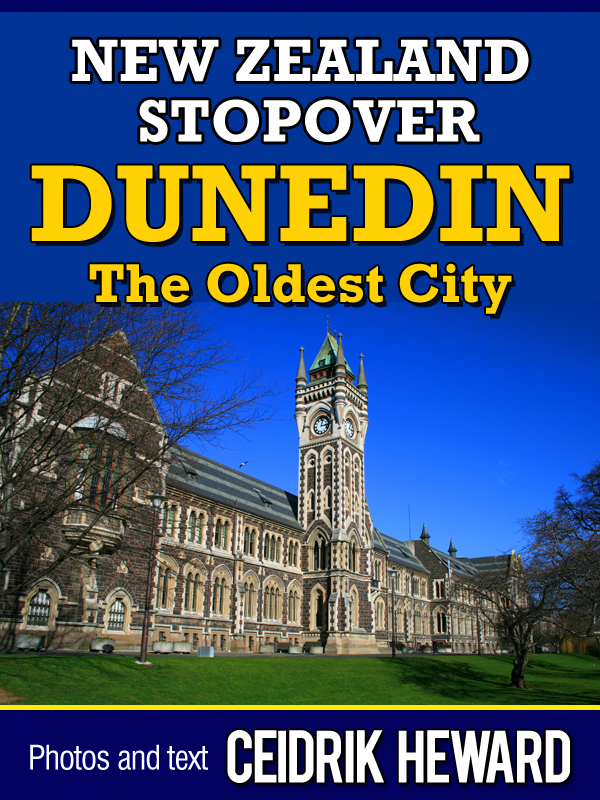

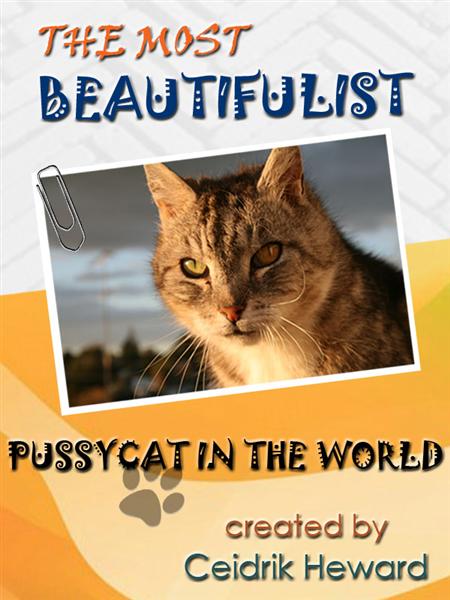
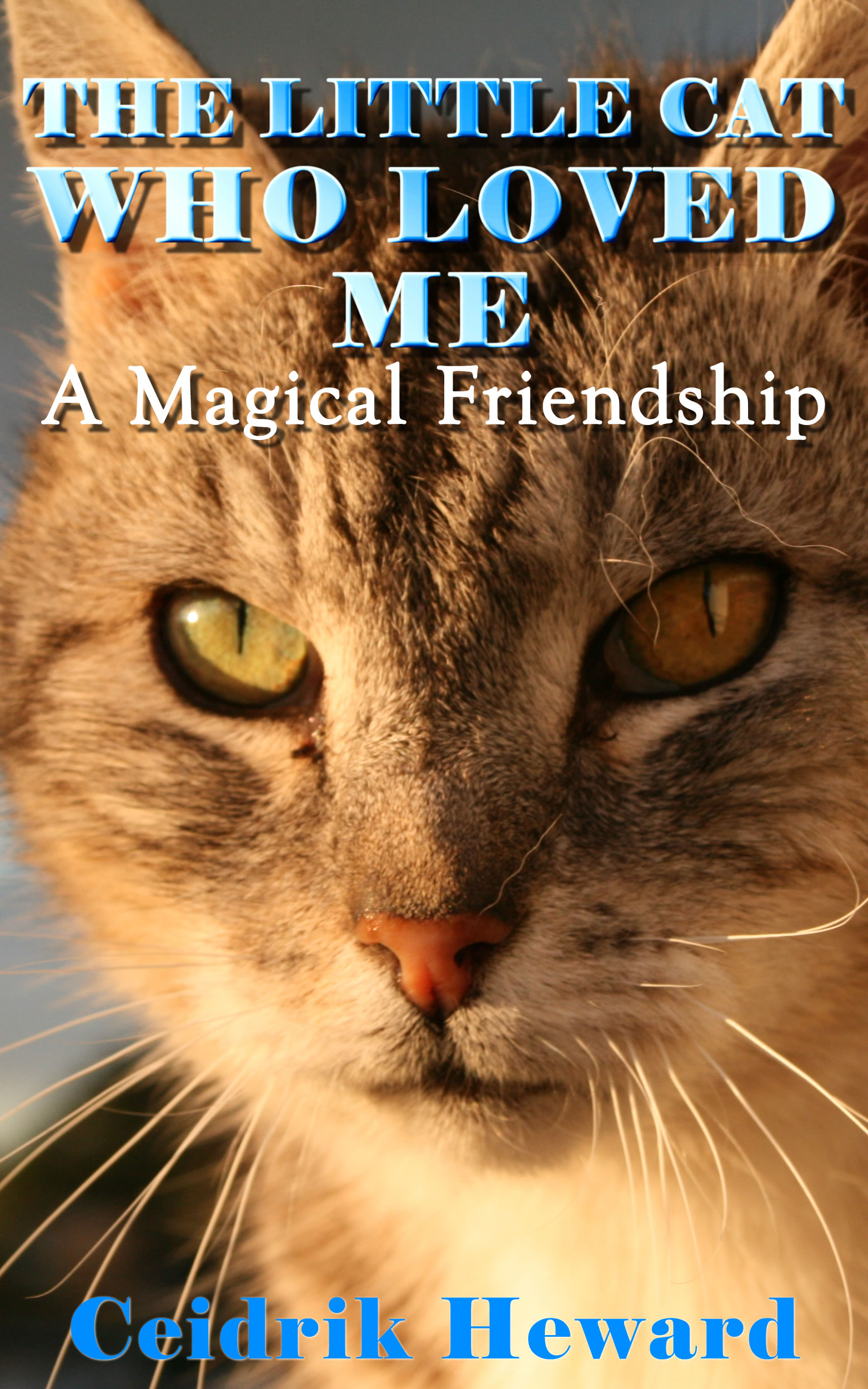







 Visit Today : 209
Visit Today : 209 Total Visit : 1133386
Total Visit : 1133386
Speak Your Mind